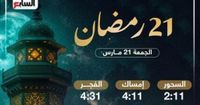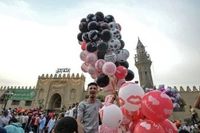The International Astronomy Center has announced that many Muslim countries will be looking for the crescent moon for the month of Shawwal on Saturday, March 29, 2025, marking the celebration of Eid al-Fitr (1446 AH). The center noted the crescent's visibility will be impossible from the eastern parts of the world and that methods of observation, whether by the naked eye, telescopes, or astronomical photography, will not yield results.
Across the Arab and Islamic world, the sighting will be particularly challenging, with only a chance of visibility from central and northern parts of the American continent. A detailed assessment suggests that the crescent may be seen through telescopes, but only under difficult conditions such as from limited areas in the Pacific Ocean west of the United States.
A closer look at the lunar calculations by the International Astronomy Center shows that in various cities around the world, specific conditions will impact sighting attempts. For instance, in Jakarta, the moon will set six minutes before sunset, making visibility impossible. In Muscat, the moon will set five minutes after sunset with an age of one hour and 48 minutes, at a distance of 1.5 degrees from the sun.
Likewise, in Mecca, the moon will set eight minutes after sunset, with an age of three hours and 28 minutes, positioned 2.2 degrees away from the sun. Observers in Amman and Jerusalem will see the moon set 11 minutes after sunset, aged three hours and 55 minutes, and at a distance of 2.3 degrees from the sun. Meanwhile, Cairo's astronomers will note a similar timing, with the moon setting 11 minutes after sunset but aged four hours and 17 minutes and 2.4 degrees from the sun.
In Rabat, the moon will set 19 minutes after sunset, showing an age of eight hours and 5 minutes and a distance of 3.8 degrees. Lastly, in Amsterdam, observers will witness the moon setting 24 minutes after sunset, with an age of six hours and 49 minutes and a distance of 3.5 degrees from the sun.
Transitioning to another vital calendar event during this month, Friday, March 21, 2025, marks the 21st day of Ramadan, with significant observations for the times of Suhoor and Fajr prayer in Cairo. The dawn will break at 4:11 AM, while Fajr prayer commences at 4:31 AM. The sunrise will occur at 5:56 AM that morning.
Ramadan in 2025 began on Saturday, March 1, and will last for 29 days, concluding on March 29, 2025. According to the Ramadan calendar established by the astronomical institute, the first day of Ramadan will be the shortest of the month, with fasting hours at 13 hours and 20 minutes. In contrast, the last day will feature the longest fast, totaling 14 hours and 12 minutes.
Ramadan, the ninth month of the lunar calendar, follows Sha'ban and precedes Shawwal. It holds significant importance as one of the Five Pillars of Islam, making fasting during this month obligatory for all Muslims. The Prophet Muhammad - peace be upon him - emphasized the importance of Ramadan by stating, "Islam is built on five [pillars]: the testimony that there is no god but Allah and that Muhammad is His messenger, the establishment of prayer, the giving of zakat, the pilgrimage to the House [Kaaba], and fasting in Ramadan."
Throughout history, celestial bodies have played an essential role in establishing time. Their movement provides a reliable method to calculate periods, leading to the development of various calendars. Using these astronomical calculations, societies have created their own terms of timekeeping ranging from the Egyptian Calendar to the Gregorian calendar.
Each culture uses its calendar to mark significant events and observances; the lunar calendar is no exception. It is often used in various Arab countries, including Saudi Arabia, as the official state calendar. Established by Caliph Omar ibn al-Khattab, it is based on the Prophet's migration from Mecca to Medina, marked as the first year in this Islamic calendar.
As the crescent moon sighting day approaches and Ramadan reaches its midpoint, many in the Muslim world prepare for Eid al-Fitr's arrival, while also reflecting on the spiritual significance of fasting and prayer during this blessed month.


